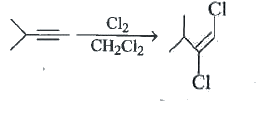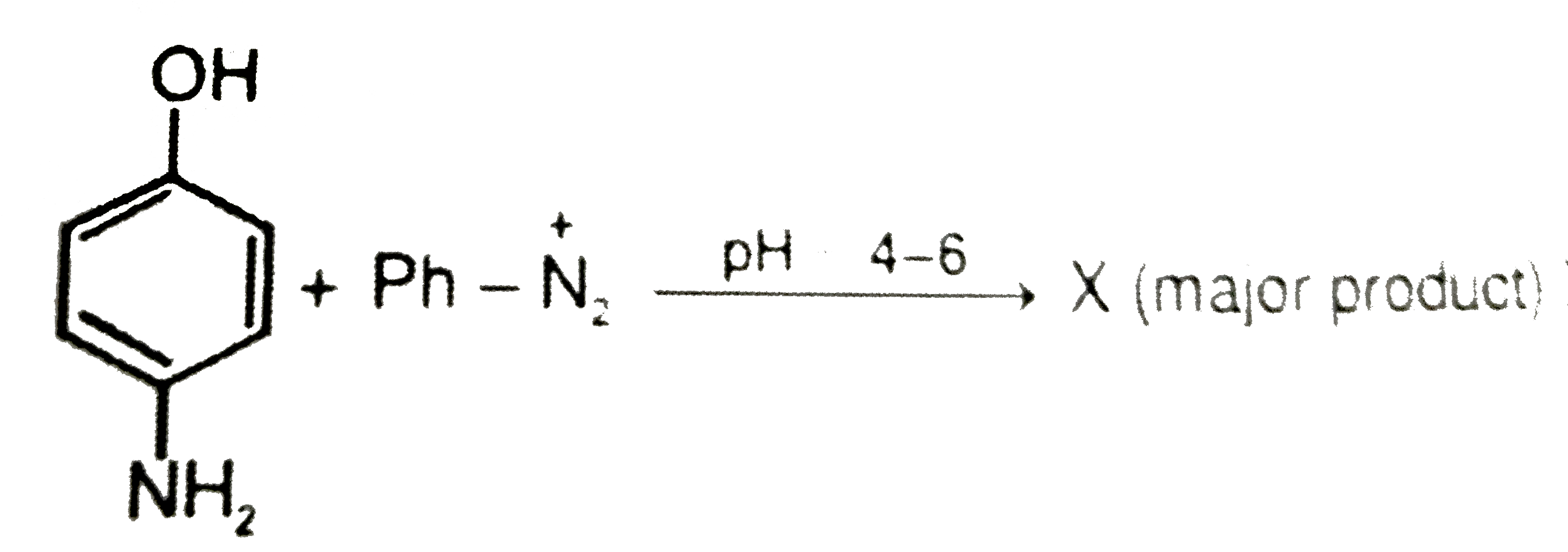2-Bromo-3,3- dimethylbutane on reaction with aqueous KOH yields X as the major product. X is
2,3,-trimethylpropan-1-ol
2,2-dimethlbutan-3-ol
2,3- dimethylbutan-2-ol
2,2-dimethylpropan-2-ol
The correct Answer is:C
To solve the question regarding the reaction of 2-Bromo-3,3-dimethylbutane with aqueous KOH, we will follow these steps:
Step 1: Identify the Structure of 2-Bromo-3,3-dimethylbutane
The molecular structure of 2-bromo-3,3-dimethylbutane can be represented as follows:
- The longest carbon chain contains 4 carbon atoms (butane).
- The bromine atom is attached to the second carbon.
- There are two methyl groups attached to the third carbon.
The structure can be drawn as:
CH3|CH3−C−CH−CH3|Br
Step 2: Determine the Type of Reaction
When 2-bromo-3,3-dimethylbutane reacts with aqueous KOH, it undergoes a nucleophilic substitution reaction. Given that KOH is in aqueous solution, the reaction will likely follow the SN1 mechanism due to the formation of a stable carbocation.
Step 3: Formation of Carbocation
In the first step of the SN1 mechanism, the bromine atom (a good leaving group) leaves, forming a carbocation. The structure of the carbocation formed is:
CH3∣∣CH3−C±CH−CH3∣∣
This is a secondary carbocation.
Step 4: Carbocation Rearrangement
To achieve a more stable carbocation, a methyl shift can occur. A methyl group from one of the adjacent carbons can move to the positively charged carbon, leading to a more stable tertiary carbocation:
CH3|CH3−C−CH3|C+
Step 5: Nucleophilic Attack by OH⁻
The hydroxide ion (OH⁻) from KOH will now attack the carbocation, resulting in the formation of the alcohol:
CH3|CH3−C−CH3|OH
Step 6: Naming the Product
The final product is 2,3-dimethylbutan-2-ol. The numbering starts from the end of the chain closest to the hydroxyl group (OH), giving it the lowest possible number. The structure can be named as follows:
- The longest carbon chain is butane (4 carbons).
- The hydroxyl group is on the second carbon.
- There are two methyl groups on the second and third carbons.
Thus, the name of the product is 2,3-dimethylbutan-2-ol.
Conclusion
The major product (X) formed from the reaction of 2-bromo-3,3-dimethylbutane with aqueous KOH is 2,3-dimethylbutan-2-ol.
---
The molecular structure of 2-bromo-3,3-dimethylbutane can be represented as follows:
- The longest carbon chain contains 4 carbon atoms (butane).
- The bromine atom is attached to the second carbon.
- There are two methyl groups attached to the third carbon.
CH3|CH3−C−CH−CH3|Br
When 2-bromo-3,3-dimethylbutane reacts with aqueous KOH, it undergoes a nucleophilic substitution reaction. Given that KOH is in aqueous solution, the reaction will likely follow the SN1 mechanism due to the formation of a stable carbocation.
In the first step of the SN1 mechanism, the bromine atom (a good leaving group) leaves, forming a carbocation. The structure of the carbocation formed is:
CH3∣∣CH3−C±CH−CH3∣∣
This is a secondary carbocation.
To achieve a more stable carbocation, a methyl shift can occur. A methyl group from one of the adjacent carbons can move to the positively charged carbon, leading to a more stable tertiary carbocation:
CH3|CH3−C−CH3|C+
The hydroxide ion (OH⁻) from KOH will now attack the carbocation, resulting in the formation of the alcohol:
CH3|CH3−C−CH3|OH
The final product is 2,3-dimethylbutan-2-ol. The numbering starts from the end of the chain closest to the hydroxyl group (OH), giving it the lowest possible number. The structure can be named as follows:
- The longest carbon chain is butane (4 carbons).
- The hydroxyl group is on the second carbon.
- There are two methyl groups on the second and third carbons.
The major product (X) formed from the reaction of 2-bromo-3,3-dimethylbutane with aqueous KOH is 2,3-dimethylbutan-2-ol.
Topper's Solved these Questions
- BOOK - NCERT FINGERTPS ENGLISHCHAPTER - HALOALKANES AND HALOARENESEXERCISE - Higher order thinking skills8videos
HALOALKANES AND HALOARENES
- BOOK - NCERT FINGERTPS ENGLISHCHAPTER - HALOALKANES AND HALOARENESEXERCISE - Exemplar problems24videos
HALOALKANES AND HALOARENES
- BOOK - NCERT FINGERTPS ENGLISHCHAPTER - HALOALKANES AND HALOARENESEXERCISE - Physical properties7videos
HALOALKANES AND HALOARENES
- BOOK - NCERT FINGERTPS ENGLISHCHAPTER - GENERAL PRINCIPLES AND PROCESSES OF ISOLATION OF ELEMENTSEXERCISE - Assertion And Reason15videos
GENERAL PRINCIPLES AND PROCESSES OF ISOLATION OF ELEMENTS
- BOOK - NCERT FINGERTPS ENGLISHCHAPTER - POLYMERS EXERCISE - NCERT Exemplar9videos
POLYMERS
Similar Questions
Knowledge Check
- Question 1 - Select One
2-Chloro-2-methylpropane on reaction with aqueous KOH gives X as the major product. X is
Abut-2-eneB2-methylbut-1-eneC2-methylprop-1-eneD2-methylbutan-2-ol - Question 2 - Select One
 Find major product (X):A
Find major product (X):A B
B C
C D
D
- Question 3 - Select One
Which reaction yields the major product shown?
A B
B C
C D
D
 X (major product ) X will be -View Solution
X (major product ) X will be -View Solution2-Chlorobutane on treatment with alcoholic KOH/Δ gives major product :
View Solution
Hydrocarbon (X) major product X isView SolutionWhich of the following reactions will not yield alcohol as the major product ?
View SolutionHeating of 2-chloro-1-phenylbutane with EtOK/EtOH gives X as the major product. Reaction of X with Hg(PAc)2/H2O followed by gives Y as the major product. Y is :
View Solution


